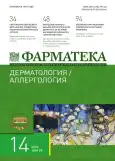Mental status and quality of life in pediatric patients with alopecia areata: a cross-sectional (questionnaire) study
- Authors: Dogov A.M1, Murashkin N.N.1,2,3, Ambarchyan E.T4, Nezhvedilova R.Y.1, Fedorov D.V1
-
Affiliations:
- National Medical Research Center for Children's Health
- Sechenov University
- Central State Medical Academy of the Administrative Department of the Presidentof the Russian Federation
- Research Institute of Pediatrics and Children's Health, Central Clinical Hospital of the Russian Academy of Sciences
- Issue: Vol 29, No 14 (2022)
- Pages: 55-61
- Section: Articles
- Published: 20.12.2022
- URL: https://journals.eco-vector.com/2073-4034/article/view/321159
- DOI: https://doi.org/10.18565/pharmateca.2022.14.55-61
- ID: 321159
Cite item
Abstract
Keywords
Full Text
About the authors
A. M Dogov
National Medical Research Center for Children's HealthMoscow, Russia
Nikolai N. Murashkin
National Medical Research Center for Children's Health; Sechenov University; Central State Medical Academy of the Administrative Department of the Presidentof the Russian Federation
Email: m_nn2001@mail.ru
Dr. Sci. (Med.), Head of the Department of Dermatology with a Group of Laser Surgery; Head of the Laboratory of Skin Pathology in Children; Professor at the Department of Dermatovenereology and Cosmetology Moscow, Russia
E. T Ambarchyan
Research Institute of Pediatrics and Children's Health, Central Clinical Hospital of the Russian Academy of SciencesMoscow, Russia
R. Yu Nezhvedilova
National Medical Research Center for Children's HealthMoscow, Russia
D. V Fedorov
National Medical Research Center for Children's HealthMoscow, Russia
References
- Arzu K. New Modalities in the Treatment of Refractory Alopecia Areata. 2017. doi: 10.5772/66591.
- Alkhalifah A., Alsantali A., Wang E., et al. Alopecia areata update: part I. Clinical picture, histopathology, and pathogenesis. J Am Acad Dermatol. 2010;62:177-88. Doi: 10.1016/j. jaad.2009.10.032.
- Villasante Fricke A.C., Miteva M. Epidemiology and burden of alopecia areata: a systematic review. Clin Cosmet Investig Dermatol. 2015;8:397-403. doi: 10.2147/CCID. S53985.
- Guzmn-Snchez D.A., Villanueva-Quintero G.D., Alfaro Alfaro N., McMichael A. A clinical study of alopecia areata in Mexico.Int J Dermatol. 2007;46(12):1308-10. doi: 10.1111/j.1365-4632.2007.03320.x.
- Alzolibani A.A. Epidemiologic and genetic characteristics of alopecia areata part. Acta Dermatovenerol Alp Pannonica Adriat. 2011;20:191-98.
- Lee H, Jung S.J., Patel A.B., et al. Racial characteristics of alopecia areata in the United States. J Am Acad Dermatol. 2020;83(4):1064-70. Doi: 10.1016/j. jaad.2019.06.1300.
- Антропов Ю.Ф., Балабанова В.А., Шарова Н.М. Особенности психического статуса детей с гнездной алопецией. Педиатрия. Журнал им. ГН. Сперанского. 2004;4.
- Hwang S., Shin J., Kim T.-G., et al. Large-scale Retrospective Cohort Study of Psychological Stress in Patients with Alopecia Areata According to the Frequency of Intralesional Steroid Injection. Acta Dermatol Venereol. 2019;99(2):236-37. Doi: 0.2340/00015555-3079.
- Ghanizadeh A.Comorbidity of psychiatric disorders in children and adolescents with alopecia areata in a child and adolescent psychiatry clinical sample.int J Dermatol. 2008;47(11):1118-20. doi: 10.1111/j.1365-4632.2008.03743.x.
- Юлдашев В.Л., Гафаров М.М., Галимов Р.К. Психологические особенности больных детей и подростков, страдающих гнездной алопецией. Российский журнал кожных и венерических болезней. 2009;1:54-7.
- Mendoza T.R., Osei J., Duvic M. The Utility and Validity of the Alopecia Areata Symptom impact Scale in Measuring Disease-Related Symptoms and their Effect on Functioning. J investig Dermatol. Symp. Proc. 2018;19(1):S41-6. Doi: 10.1016/j. jisp.2017.10.009.
- Fabbrocini G., Panariello L., De Vita V., et al. Quality of life in alopecia areata: a disease-specific questionnaire. J Eur Acad Dermatol Venereol. 2013;27(3):e276-81. doi: 10.1111/j.1468-3083.2012.04629.x.
- Manolache L., Petrescu-Seceleanu D., Benea V. Alopecia areata and relationship with stressful events in children. J Eur Acad Dermatol Venereol. 2009;23:107-9.
- Liakopoulou M., Alifieraki T, Katideniou A., et al. Children with alopecia areata: psychiatric symptomatology and life events. J Am Acad Child Adolesc Psychiatry. 1997;36:678-84.
- Андрюшенко А.В., Дробижев М.Ю., Добровольский А.В. Сравнительная оценка шкал CES-D, BDi и HADS(d) в диагностике депрессий в общемедицинской практике. Журнал неврологии и психиатрии. 2003;5:11-7.
- Tan E., Tay Y-K., Goh C.-L., Giam Y.C. The pattern and profile of alopecia areata in Singapore - a study of 219 Asians.int J Dermatol. 2002;41(11): 748-53.
- Kavak A., Yeildal N., Parlak A.H., et al. Alopecia areata in Turkey: demographic and clinical features. J Eur Acad Dermatol Venereol. 2008;22(8):977-81.
- Wasserman D., Guzman-Sanchez D.A., Scott K., Mcmichael A. Alopecia areata.int J Dermatol. 2007;46(2):121-31.
- Dubois M., Baumstarck-Barrau K., Gaudy-Marqueste C., et al. Quality of life in alopecia areata: a study of 60 cases. J investig Dermatol. 2010;130(12):2830-33.
- Gulec A.T, Tanriverdi N., Dr D., et al. The role of psychological factors in alopecia areata and the impact of the disease on the quality of life.int J Dermatol. 2004;43(5):352-56.
- Firooz A., Firoozabadi M.R., Ghazisaidi B., Dowlati Y Concepts of patients with alopecia areata about their disease. BMC. Dermatol. 2005;5.
- Papadopoulos L., Bor R. Psychol. Approach. Dermatol. Leicester, UK: BPS Books/in lived experience of AA; 1999.
- Masmoudi J., Sellami R., Ouali U., et al. Quality of life in alopecia areata: a sample of tunisian patients. Dermatol Res. Pract 2013;2013:983804. doi: 10.1155/2013/983804.
Supplementary files





